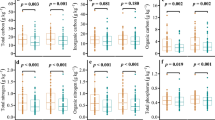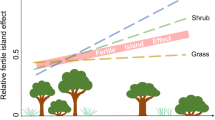Abstract
Zones of nutrient enrichment beneath shrubs, the so called 'fertile islands', are the result of a range of interacting physical and biotic concentrating mechanisms. These concentrating mechanisms lead to specific spatial patterns of soil properties across a landscape and it has been suggested that disruption of the normal patterns into more aggregated 'fertile islands' might be a useful index of desertification in semi-arid regions. The objective of this paper was to determine whether 'fertile islands' are as characteristic a feature of succulent deserts as they are of shrub dominated deserts. Results indicate that, even in a community dominated by succulent species fertile islands develop under extremely arid conditions and that the degree of development is dependent on plant dynamics. Long-lived species showed greater concentration effects. However, the patterns of nutrient accretion in islands are very different to shrub invaded grasslands in North America. In particular nitrogen accretion dominated the 'fertile islands' in Namaqualand, and we suggest that these islands are more ephemeral than carbon and phosphorus dominated islands reported for other systems. These more dynamic islands are a consequence of rapid community dynamics since the Namaqualand region is characterised by many short-lived perennials which turnover generations very rapidly in response to environmental conditions. Using the development of 'fertile islands' to assess desertification as applied elsewhere might be inappropriate in Namaqualand because of the different patterns of community dynamics underlying the formation and characteristics of these islands.
Similar content being viewed by others
References
Acocks, J. P. H. 1953. Veld types of South Africa. Mem. Bot. Surv. S. A. 28. Bot. Res. Inst. Pretoria.
Allsopp, N. 1999. Effects of grazing and cultivation on soil patterns and processes in the Paulshoek area of Namaqualand. Plant Ecol. 142: 179-187 (this issue).
Arnold, T. H. & De Wet, B. C. 1993. Plants of southern Africa: names and distribution. Bot. Sur. S. A. 62. Bot. Res. Inst. Pretoria.
Bhat, K. K. S. & Nye, P. H. 1974 Diffusion of phosphate to plant roots in soil. III. Depletion around onion roots without root hairs. Plant Soil 41: 383-394.
Bittrich, V. & Hartmann, H. 1988. The Aizoaceae-a new approach. Bot. J. Linn. Soc. 97: 239-254.
Charley, J. L. & West, N. E. 1975. Plant-induced soil chemical patterns in some shrub-dominated semi-desert ecosystems of Utah. J. Ecol. 63: 945-964.
Charley, J. L. & West, N. E. 1977. Micro-patterns of nitrogen mineralization activity in soils of some shrub-dominated semi-desert ecosystems of Utah. Soil Biol. Biochem.9: 357-365.
Cowling, R. M., Esler, K. J. & Rundel, P. W. 1999. Namaqualand, South Africa-and overview of a unique winter-rainfall desert ecosystem. Plant Ecol. 142: 3-21 (this issue).
Desmet, P. G. 1996. Vegetation and restoration potential of the arid coastal belt between Port Nolloth and Alexander Bay, Namaqualand, South Africa. MSc thesis, University of Cape Town.
Esler, K. J., Rundel, P.W. & Cowling, R. M. In press. The succulent karoo in a global context: plant structural and functional comparison with North American winter rain fall deserts. In: Dean, W. R. J. and Milton, S. J. (eds), The Karoo: Ecological Patterns and Processes. Cambridge University Press, Cambridge.
Esler, K. J. In press. Plant reproductive ecology. In: Dean, W. R. J. and Milton, S. J. (eds), The Karoo: Ecological Patterns and Processes. Cambridge University Press, Cambridge.
Garcia-Moya, E. & McKell, C. M. 1970. Contributions of shrubs to the nitrogen economy of a desert-wash plant community. Ecology 51: 81-88.
Garner, W. & Steinberger, Y. 1989. A proposed mechanism for the formation of 'fertile islands' in the desert ecosystem. J. Arid Env. 16: 257-262.
Gibbens, R. P. & Beck, R. F. 1985. Changes in grass basal area and forb densities over a 64-year period on grassland types of the Jornada Experimental Range. J. Range Mngment 41: 186-192.
Goldberg, D. E & Turner, R. M. 1986. Vegetation change and plant demography in permanent plots in the Sonoran Desert. Ecology 67: 695-712.
Hook, R. B., Burke, I. C. & Lauenroth, W. K. 1991. Heterogeneity of soil and plant N and C associated with individual plants and openings in North American shortgrass steppe. Plant Soil 138: 247-256.
Jürgens, N., Gotzmann, I. H. & Cowling, R. M. 1999. Remarkable medium-term dynamics of leaf succulent Mesembryanthemaceae in the winter-rainfall desert of northwestern Namaqualand, South Africa. Plant Ecol. 142: 87-96 (this issue).
Lovegrove, B. G. & Siegfried, W. R. 1989. Spacing and origin(s) of Mima-like earth mounds in the Cape Province of South Africa. S. A. J. Sci. 85: 108-112.
Midgley, G. F. & Musil, C. F. 1990.Substrate effects of zoogenic mounds on vegetation composition in the Worcester-Robertson valley, Cape Province. S. A. J. Bot. 56: 158-166.
Mitchell, D. T., Brown, G. & Jongens-Roberts, S. M. 1984. Variation and forms of phosphorus in the sandy soils of coastal fynbos, south-western Cape. J. Ecol. 72: 575-584.
Milton, S. J. & Hoffman, M. T. 1994. The application of stateand-transition models to rangeland researchand management in arid succulent and semi-arid grassy Karoo, South Africa. Afr. J. Range Forage Sci. 11: 18-26.
Milton, S. J., Yeaton, R. I., Dean, W. R. J. & Vlok, J. H. J. 1997. Succulent karoo. pp. 131-166. In: Cowling, R. M., Richardson, D. M. & Pierce, S. M. (eds), Vegetation of Southern Africa. Cambridge University Press, Cambridge.
Murphy, J. & Riley, J. P. 1962. A modified single resolution method for the determination of phosphate in natural waters. Anal. Chim. Acta 27: 31-36.
Schlesinger, W. H., Reynolds, J. F., Cunningham, G. L., Huenneke, L. F., Jarrell, W. M., Virginia, R. A. & Whitford, W. G. 1990. Biological feedbacks in global desertification. Science 247: 1043-1048.
Schlesinger, W. H., Raikes, J. A., Hartley, A. E. & Cross, A. F. 1996. On the spatial pattern of soil nutrients in desert ecosystems. Ecology 77: 364-374.
Stock, W. D. & Lewis, O. A. M. 1986. Soil nitrogen and the role of fire as a mineralizing agent in a South African coastal fynbos ecosystem. J. Ecol. 74: 317-328.
Todd, S. W. & Hofmann, M. T. 1999. A fence-line contrast reveals effects of heavy grazing on plant diversity and community composition in Namaqualand, South Africa. Plant Ecol. 142: 169-178 (this issue).
Tongway, D. J., Ludwig, J. A. & Whitford, W. G. 1989. Mulga log mounds: Fertile patches in the semi-arid woodlands of eastern Australia. Aust. J. Ecol. 14: 263-268.
Vasek, F. C. 1980. Creosote bush: long-lived clones in the Mojave Desert. Am. J. Bot. 67: 246-255.
Vinton, M. A. & Burke, I. C. 1997. Contingent effects of plant species on soils along a regional moisture gradient in the Great Plains. Oecologia 110: 393-402.
Virginnia, R. A. & Jarrell, W. M. 1983. Soil properties in a mesquite-dominated Sonoran Desert Ecosystem. Soil Sci. Soc. Am. J. 47: 138-144.
von Willert, D. J, Eller, B. M., Werger, M. J. A., Brinckmann, E. & Ihlenfeldt, H. D. 1992. Life Strategies of Succulents in Deserts. Cambridge University Press, Cambridge.
Werger, M. J. A. & Ellis, R. P 1981. Photosynthetic pathways in the arid regions of South Africa. Flora 171: 64-75.
Whitford, W. G., Anderson, J. & Rice, P. M. 1997. Stemflow contribution to the 'fertile island' effect in creosotebush, Larrea tridentata. J. Arid Env. 35: 451-457.
Rights and permissions
About this article
Cite this article
Stock, W., Dlamini, T. & Cowling, R. Plant induced fertile islands as possible indicators of desertification in a succulent desert ecosystem in northern Namaqualand, South Africa. Plant Ecology 142, 161–167 (1999). https://doi.org/10.1023/A:1009874328546
Issue Date:
DOI: https://doi.org/10.1023/A:1009874328546




